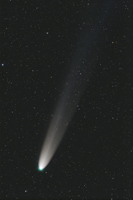|
%202021-12-20-sm-tn.jpg)
|
2021 December
20: a nice early Christmas present! Photographed
against the stars of Microscopium when about magnitude
3, but low altitude. Canon 5D II + 500mm lens + 1.4X extender, on an NEQ6 Pro mount tracking the sky.
A series of
fifty 20sec exposures (~16 mins total) at f7.1 and ISO 1000 were aligned on
the comet, while six of the images (2 mins total) were separately aligned on
the stars. These were combined to optimise the comet against the star field; field of view
3° x 2°,
north is to the right.
|
|
_2021-12-21%20(June24)-tn.jpg)
|
2021 December
21: when at ~mag 3.5 against the stars of Microscopium, one day after outburst. Very nice fine structures in the ion
tail.
Equipment
as above; a series of
fifteen 15sec exposures (~4 mins total) at f8 and ISO 6400 were aligned on
the comet, while four of the images (1 min total) were separately aligned on
the stars. These were combined to optimise the comet against the star field; field of view
3° x 2°,
north is to the right.
|
|
-port-tn.jpg)
|
2021
December 27: about magnitude 5 when photographed
against the stars of Microscopium. The ion tail is clearly seen as a
narrow structure extending to the top of the field.
Takahashi
TOA-130 with 0.7X focal reducer + Takahashi EM-200 Temma2 mount + SBIG
STL11000M camera, fl=720mm, f5.6; 160 secs each of R, G and B filtered
frames (8 min in total) were calibrated, aligned and combined; field of view
2.9° x 1.9°,
north is to the right.
|
-port-tn.jpg) |
2021
December 28: about magnitude 5 when photographed
against the stars of western Piscis
Austrinus. Another outburst has resulted in major changes in the ion tail,
including a disconnection event about 3/4 of the way along the tail.
Equipment as
above; 8 x 90 secs exposures of R, G and B
filtered frames (36 min in total) were calibrated, aligned and combined; field of view
2.9° x 1.9°,
north is to the right.
|
 |
2021
December 29: about magnitude 5 when photographed
against the stars of western Piscis Austrinus. At least two fine filaments
are visible in the ion tail.
Equipment as
above; 6 x 120 secs exposures of R, G and B
filtered frames (36 min in total) were calibrated, aligned and combined; field of view
2.9° x 1.9°,
north is to the right.
|